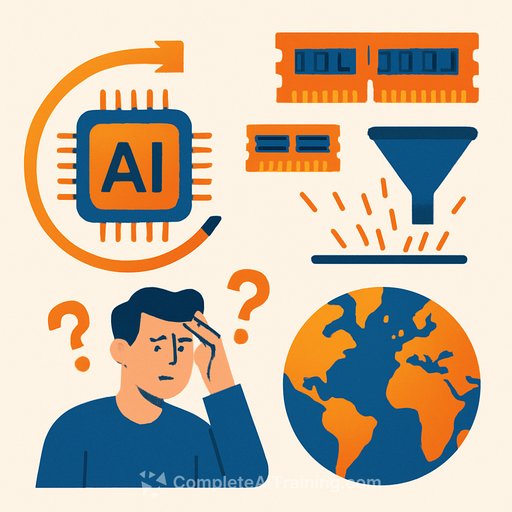The Enduring Squeeze: AI's Insatiable Demand Is Redefining Semiconductor Reality in 2025
As of October 2025, the chip crunch didn't end. It shifted. The broad shortage of 2020-2022 has given way to a focused scarcity of advanced AI components. For product teams, this is a constraint you can't ignore and a strategy problem you must solve.
AI demand is setting records, yet the bottlenecks sit in a few pressure points: advanced nodes, advanced packaging, high-bandwidth memory, and skilled people. The result: longer lead times, higher unit costs, and forced sequencing of features and SKUs.
What's Actually Scarce Right Now
- Advanced process nodes: 7nm → 3nm today; 2nm (GAA) ramps begin late 2025 with TSMC, Samsung, and Intel competing. Yield and capacity are tight by design.
- Advanced packaging: CoWoS capacity is the choke point. NVIDIA reportedly locked up a large share of TSMC's CoWoS-L for Blackwell GPUs. Even with TSMC targeting ~70k wafers/month by YE2025 and >90k in 2026, demand outruns supply.
- ABF substrates: a persistent, less visible constraint throttling packaging throughput.
- HBM: ongoing tightness forces prepayments and long-term commitments with SK Hynix, Micron, and Samsung.
- Talent: a severe shortage across design, manufacturing, operations, and maintenance. This is structural and slows everything.
How 2025 Differs From 2020-2022
- Not a general chip shortage. It's AI accelerators, advanced packaging, and HBM.
- Geopolitics plays a larger role. Export controls directly affect access to tools, nodes, and products.
- Hidden constraints deep in supply chains (substrates, packaging steps, skilled labor) limit upstream options.
What This Means For Product Development
- Roadmaps bend to packaging slots and HBM allocations as much as to compute targets.
- Feature sequencing matters: prioritize SKUs that monetize scarce silicon and memory first.
- Cost curves shift: expect higher COGS, NCNR terms, and longer CTB. Plan pricing and margin buffers now.
- Design choices must assume scarcity: multi-sourcing, alternative nodes, chiplet options, and "graceful degrade" modes.
High-Impact Moves For The Next 90 Days
- Lock capacity: secure packaging slots and HBM with prepayments or take-or-pay agreements where ROI is clear.
- Re-baseline the BOM: identify pin-compatible or software-compatible alternates; validate on older nodes where acceptable.
- Sequence value: ship AI features that drive revenue per watt and revenue per mm² first; defer nice-to-have models.
- Plan variants: create two execution paths-advanced packaging + HBM and a fallback with smaller die or lower HBM stacks.
- Hedge substrates: qualify multiple ABF suppliers via OSAT partners; validate substrate stack-ups early.
- Shorten loops: stand up a cross-functional "silicon war room" (PD, supply, finance, legal) with weekly risk burndowns.
Build Medium-Term Resilience (6-24 Months)
- Design for packaging: co-develop interposer, reticle stitch, and thermal strategies with foundry/OSAT partners.
- Chiplets where feasible: smaller dies improve yield; standardize die-to-die interfaces to swap vendors when needed.
- Qualify nodes, not just parts: create portability plans across 5nm/4nm/3nm and across foundries where practical.
- Invest in AI-driven EDA and verification to shrink design cycles and improve first-pass success.
- Talent pipeline: apprenticeships, local university programs, and internal reskilling for test, yield, and packaging engineering.
- Supplier scorecards: track delivery, yield, substrate availability, and cycle time; tie future awards to performance.
- Energy planning: AI projects can be blocked by data center electricity. Secure capacity with colocations and utilities early.
Key Market Facts To Factor Into Plans
- AI chips are projected to exceed $150B in 2025 sales, dominated by generative AI, HPC, and edge inference.
- TSMC remains the center of gravity for advanced nodes and CoWoS; Arizona fab timelines have slipped to 2028.
- AI chip shortages likely persist into 2026 despite aggressive capacity adds.
- Global semiconductor revenue could pass $1T by 2030; AI accelerators could reach ~$500B by 2028.
- Data center electricity demand is projected to more than double by 2030-treat it as a gating resource.
- The talent gap may exceed one million skilled roles globally by 2030.
Geopolitics: Treat As A Product Constraint
- Export controls restrict advanced chip access for select regions. Build compliance into design and fulfillment from day one.
- Expect more regionalized production. Costs rise, resilience improves. Plan pricing and contract terms accordingly.
- Public funding is material. Track programs like the U.S. CHIPS and Science Act and the EU Chips Act for incentives, timelines, and compliance obligations.
Playbooks By Organization Type
- Hyperscalers and AI platforms: double down on custom silicon but plan for foundry and OSAT concentration risk; secure HBM years out.
- Device OEMs: prioritize SKUs with clear compute ROI; keep an alternate design ready using mature nodes for volume tiers.
- Automotive: prepare for a late-2025/2026 squeeze on mature nodes (40nm+); increase LTBs and redesign for parametric flex.
- Startups: avoid single points of failure; use chiplets, smaller batches, and staged bets; partner for shared packaging slots.
Operational Metrics To Review Weekly
- Lead times and NCNR exposure by component (HBM, substrates, interposers, reticles).
- Allocation coverage: weeks of HBM and substrate on-hand vs. build plan.
- Packaging slot adherence and slip causes; rework rates.
- Yield trend by die and by package; fallout at burn-in and system test.
- Unit economics: $/TOPS, $/mm², revenue per watt, gross margin per SKU under current allocations.
Where AI Helps Your Supply Chain Now
- Predictive analytics: earlier signal on substrate shortages, HBM supply, and factory cycle-time swings.
- Scenario planning: fast "what-if" for SKU prioritization under different allocation and yield assumptions.
- Quality and yield: root-cause detection from test logs and inline sensing; faster ECO cycles.
- Energy optimization: workload placement and model scheduling to cut electricity constraints as a blocker.
Outlook
This is a targeted, persistent shortage. It centers on advanced nodes, advanced packaging, HBM, and talent. Expect tight supply into 2026, higher costs, and more dependencies on packaging slots than on wafer starts alone.
The upside: the push is forcing better designs, better planning, and better partnerships. Teams that commit to multi-source architectures, packaging-aware design, and talent development will ship more predictably and protect margins while others wait.
Next Steps For Product Teams
- Rebuild your 2026 roadmap around packaging and HBM gates, not just model accuracy or TOPS targets.
- Stand up supplier JDMs that include DFM-for-packaging and substrate commitments.
- Lock energy capacity for AI workloads; tie compute plans to electricity availability and costs.
- Upskill your team on AI development workflows and automation to shorten design-test cycles.
If you need structured upskilling for product and engineering teams on AI tooling and workflows, see curated options by job role here: Complete AI Training - Courses by Job.
Your membership also unlocks:






